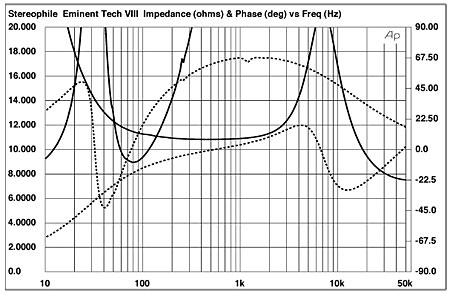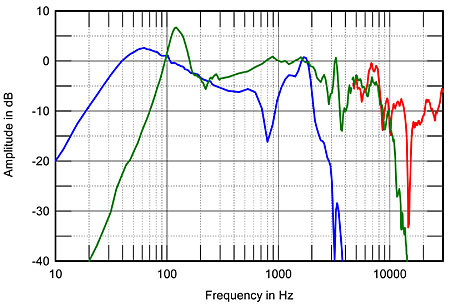| Columns Retired Columns & Blogs |
Eminent Technology LFT-VIII loudspeaker Measurements
Sidebar 3: Measurements
Though Eminent Technology specifies the LFT-VIII's sensitivity as 83dB/W/m, I couldn't get anywhere near that figure, my B-weighted sensitivity on the midrange axis being some 4.7dB lower than that of the BBC LS3/5A, which weighs in at around 82.5dB/Wm. Partly this is because the British speaker has a rising treble compared with the Eminent's sloped-down high end (see later). Even so, looking at just the octave band centered on 1kHz, the LFT-VIII still played 2dB quieter than the LS3/5A for the same 2.83V input. This is a speaker that needs to be fed plenty of volts to reach rock'n'roll levels.
The separate impedance plots for the woofer and panel (with the tweeter set to its maximum level) can be seen in fig.1. The sealed-box woofer is tuned to 32.5Hz (the peak at that frequency reaches a value of 53 ohms), while, apart from the peak in the mid-treble due to the crossover between the midrange and treble ribbons, the panel pretty much approximates an 11 ohm resistor. Note that the ribbon is still drawing current in the woofer's passband; the impedance plot for the system is shown in fig.2. Because the panel and woofer are in parallel in the upper bass, the combined impedance drops to a minimum of 5.2 ohms at 78Hz. The phase angle remains quite benign, however, meaning that the speaker is basically a moderate load.

Fig.1 Eminent Technology LFT-VIII, electrical impedance (solid) and phase (dashed) of woofer and panel sections individually. (2 ohms/vertical div.)

Fig.2 Eminent Technology LFT-VIII, electrical impedance (solid) and phase (dashed). (2 ohms/vertical div.)
When it comes to the measurements of the LFT-VIII's frequency response, it should be mentioned from the outset that with a panel speaker like this, it's all too easy to get depressed by what appear to be sharp peaks and dips. Because the speaker's radiating area is so large, however, the measurements are plagued with interference effects at the necessarily close measuring distance. These will change dramatically even if the measuring microphone is moved slightly. As these effects are much less severe at typical listening distances of 8' or more, and the ear is relatively immune to them anyway, try, when looking at the following curves, to smooth out the peaks and dips by eye to get an idea of the overall response trend. Some of the peaks will be due to resonances, however. I will examine the evidence for this later.
Fig.3 shows five basic curves: a) the response of the woofer measured in the nearfield and plotted up to 200Hz (blue trace); b) this is spliced to the quasi-anechoic response of the woofer measured on the midrange ribbon axis at a distance of 45" (blue) with the DRA Labs MLSSA system and a calibrated B&K microphone; c) the nearfield response of the midrange ribbon is plotted up to 500Hz (black trace); d) this is then spliced to the quasi-anechoic response of the midrange ribbon alone (black; the curve which reaches –40dB at 14kHz); e) finally, the combined response of the midrange and tweeter ribbons is shown (red trace; this starts at 30kHz and extends down to 4.5kHz, below which it is indistinguishable from the curve of the midrange alone).

Fig.3 Eminent Technology LFT-VIII, response of woofer (blue), midrange panel (green), and midrange+tweeter (red) on midrange axis at 45", corrected for microphone response, with the nearfield woofer and midrange responses plotted below 200Hz and 500Hz, respectively.
The woofer has an appropriate bandpass characteristic centered on 60Hz. Its Q is apparently higher than specified, which would correlate with Corey's feeling that its quality was somewhat "puffy." Unfortunately, its rollout in the midrange is disturbed by a sharp peak centered on 1690Hz, which comes back up to the drive-unit's reference level. I could hear this peak as a noticeable whistle added to the sound of the MLS noise when I performed the measurements on the woofer. Fig.4, the woofer's cumulative spectral-decay, or "waterfall," plot, taken with a 30kHz bandwidth test signal on the midrange axis, shows this peak to be due to a resonance, the suckout beneath it possibly being some kind of interference effect.

Fig.4 Eminent Technology LFT-VIII, cumulative spectral-decay plot of woofer at 45" (0.15ms risetime).
The midrange ribbon can be seen from fig.3 to have a fundamental resonance at 121Hz—this apparent in the nearfield but probably not a factor at normal listening distances—with then a smooth but gently rising response to 2kHz, above which there are a series of peaks and dips superimposed upon a gently falling response until 9kHz or so, above which its output drops like a stone. If you ignore the sharp notch at 14.5kHz, which is an interference effect on this axis, the tweeter ribbon can be seen to fill in the response above 10kHz, though its level is shelved-down even at this, its maximum setting. Like CG, I wondered why Bruce Thigpen thought it necessary to add two stages of further tweeter attenuation. The tweeter ribbon basically appears to be working in the fringe field of its magnets and is therefore quite insensitive.
Fig.5 shows how it all adds up when the speaker is driven full-range. This measurement was made 45" from the midrange ribbon, some 38" from where the floor would have been had I not raised the speaker to get as long an anechoic time window as possible for my measurement. This height is equivalent to being in the center of the tweeter ribbon. Ignoring the peaks and dips for now, the response basically slopes down all the way from 60Hz to 20kHz. The low treble is broken up by two major peaks, one at 1690Hz due to the woofer (see fig.4) and another of much higher Q (sharper), at 3285Hz (see later). The deep suckout in the tweeter's passband is due to an interference effect on this axis and is probably inconsequential at a sensible listening distance.

Fig.5 Eminent Technology LFT-VIII, anechoic response on midrange axis at 45", corrected for microphone response, with the nearfield woofer response plotted below 200Hz.
I haven't shown any of the vertical or horizontal off-axis families of curves for the Eminent Technology, as they are far too complicated to be reproduced in the magazine at our standard size. Basically, however, these show that the speaker's response trend doesn't change significantly in the vertical plane as long as you are somewhere in the general vicinity of the tweeter ribbon. Horizontally, you can adjust the mid-treble energy by experimenting with various degrees of toe-in. It would also seem that the axis giving the most top-octave energy is to the inside of the midrange ribbon, not to the tweeter side of the panel.
Fig.6 shows the LFT-VIII's impulse response on the 38"-high measurement axis and fig.7 the step response. This shows that the tweeter output is basically time-aligned with the midrange panel on this axis; though the woofer appears to be connected in inverted acoustic polarity, its step is smoothly integrated with that of the midrange panel. The latter on its own seems to have a generally excellent impulse response (fig.8) despite some obvious ringing. This is shown by fig.9, the waterfall plot calculated from fig.8, to be due to a resonance in the midrange ribbon at 3285Hz, as suspected from the amplitude plot in fig.5.

Fig.6 Eminent Technology LFT-VIII, impulse response on midrange axis at 45" (5ms time window, 30kHz bandwidth).

Fig.7 Eminent Technology LFT-VIII, step response on midrange axis at 45" (5ms time window, 30kHz bandwidth).

Fig.8 Eminent Technology LFT-VIII, impulse response of midrange panel on midrange axis at 45" (5ms time window, 30kHz bandwidth).

Fig.9 Eminent Technology LFT-VIII, cumulative spectral-decay plot of midrange panel at 45" (0.15ms risetime).
The LFT-VIII's overall cumulative spectral-decay plot is shown in fig.10. Note that the woofer resonance is noticeable in this plot, suggesting that the use of a simple, first-order rolloff for the woofer is sub-optimal.

Fig.10 Eminent Technology LFT-VIII, cumulative spectral-decay plot at 45" (0.15ms risetime).
Given these rather disappointing measurements, why did Corey like this speaker so much? He was disturbed by the lack of energy in the top two octaves, as well as the rather undercontrolled woofer alignment. I suspect that, as with other panel speakers which have measured poorly but garnered positive reviews, that the ET LFT-VIII's lack of a box, with all its associated problems, coupled with a gently sloped-down tonal balance and natural-sounding, high-placed image size, outweigh its defects. As always, you should listen for yourself.—John Atkinson
- Log in or register to post comments




































